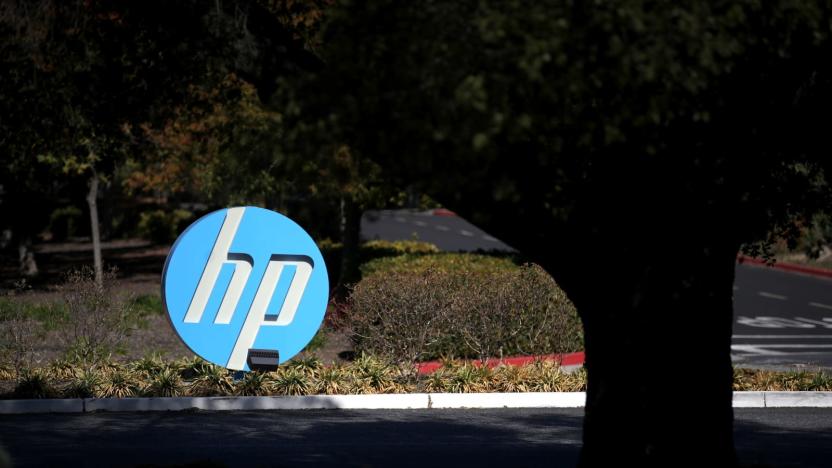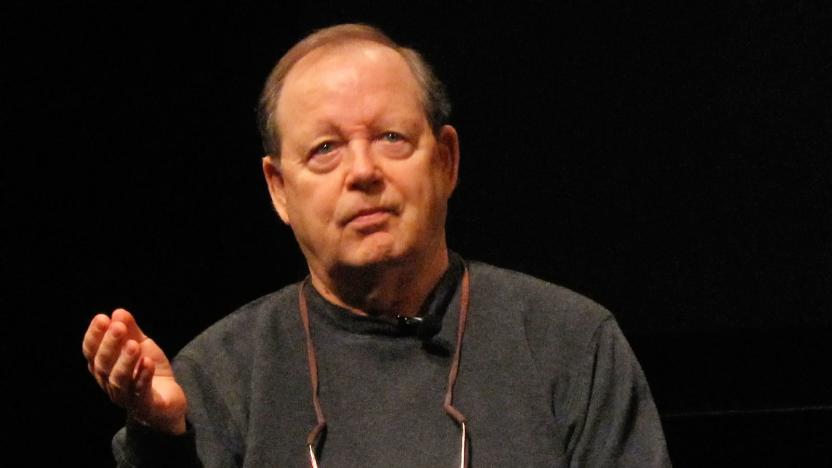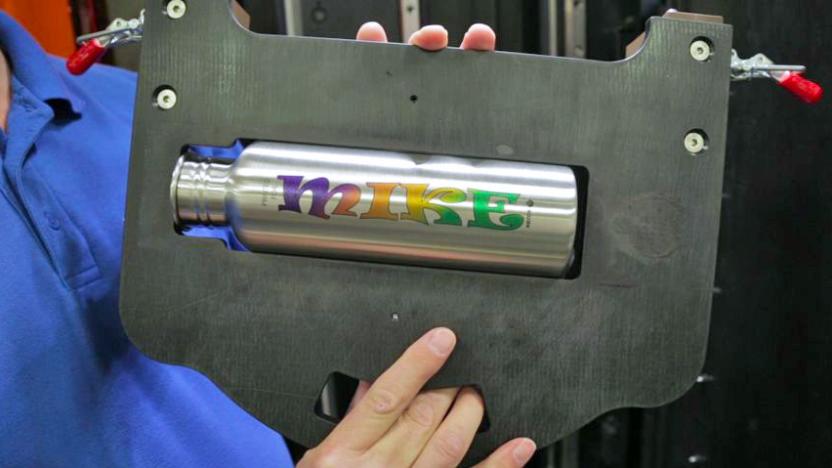xerox
Latest

HP rejects Xerox buyout offer, at least for now
HP has been receiving buyout offers as of late, but it's not ready to lose its independence -- at least, not yet. The tech pioneer has rejected a Xerox proposal to buy the company for $22 per share, arguing that the current offer "undervalues" HP and isn't in shareholders' "best interests." It also cast doubt on Xerox's ability to pull off the deal in the first place, noting Xerox's declining revenue and the prospect of massive debt for the combined company.

Internet and computing pioneer Robert Taylor dies
The technology world just lost one of its most prominent innovators. Robert Taylor, best known as the mastermind of ARPAnet (the internet's precursor), has died at 85. As the director of the US military's Advanced Research Projects Agency from 1965 until 1970, he helped pioneer the concept behind shared networks -- he was frustrated with constantly switching terminals and wanted to access multiple networks from one system. While a lot of the credit goes to his team for implementing ARPAnet, he both pushed hard for the project and wrote a legendary 1968 essay that foretold the internet's future: a vast, decentralized grid of connected devices that would reshape communication at just about every level.

Xerox shows off a machine that can print on any 3D object
Xerox's new printer works on almost any object -- even if it doesn't have a flat surface. Instead of being able to print on paper, it can print on helmets, bottle caps, water bottles, and anything else made of plastic, metals, ceramics and glass. You just stick whatever you want to mark in there and let the machine do its job. Since the printer sprays ink using nozzles half the width of human hair at around a quarter inch away, it doesn't matter if the object is smooth, rough, curved or flat.

Xerox adds instant translator feature to some of its printers
Look, we all know Xerox doesn't make the most exciting products, but its new Easy Translator Service is pretty cool. So long as you have one of its ConnectKey-enabled multifunction printers, you don't even have to type out the text you want to translate. Just scan the original document, and the machine will instantly print it out in the language you choose among the 40 37 available.

3D Systems buys a piece of Xerox to expand 3D-printing empire
We're mere weeks from 2014, and here's a sign of the times: A 3D-printing company has just picked up a piece of Xerox, a name that's still a bit hard for many to divorce from images of office printers and industrial copiers. Of course, 3D Systems isn't exactly a new kid on the block. The company may not possess the relative name recognition of a MakerBot, but it's been in the game for almost 30 years, founded by the inventor of the rapid prototyping technology that would give birth to the world of 3D printing. The $32.5 million acquisition announced this morning involves a chunk of Xerox's solid ink product design, engineering and chemistry team in Oregon with more than 100 or so employees joining 3D Systems. The team, labs and IP involved will likely have its biggest impact on 3D Systems' booming industrial wing, with the two companies having already collaborated on the Star Trekifying Projet line, which has become something of an industry standard for rapid prototyping.

Apple taps Xerox's Luca Maestri as new corporate controller
Apple's adding a big name to the executive suites in March. Xerox Executive Vice President and CFO Luca Maestri has been named as the new corporate controller of Apple. Maestri will continue to work at Xerox through February 28 to "help manage the financial leadership transition." Maestri has been with Xerox for about two years, and was previously involved with finance positions at General Motors for over 20 years including stints as the CFO of GM Europe and GM Brazil. After that, he was the CFO of Nokia Siemens Networks. The corporate controller position at Apple reports to Senior Vice President and CFO Peter Oppenheimer, who previously had the job back in the 1990s. Maestri replaces former controller Betsy Rafael, and will establish financial policies and help the company make investment decisions.

Meet your desktop's ancestors: AT&T exhumes footage of the Bell Blit (video)
AT&T's video archives are rich seams of juicy historical tidbits, and today's offering is a fine example. It's sharing footage of the Bell Blit, a graphic interface that Bell Labs developed after being inspired by the Xerox Alto. Originally named the Jerq, it was created by Rob Pike and Bart Locanthi to have the same usability as the Alto, but with "the processing power of a 1981 computer." Watch, as the narrator marvels at being able to use multiple windows at once, playing Asteroids while his debugging software runs in the background on that futuristic green-and-black display. The next time we get annoyed that Crysis isn't running as fast as you'd like it to, just remember how bad the geeks of yesteryear had it.

The Game Archaeologist: Maze War
It's hard to know how far back to go when chronicling the history of early MMOs and their ancestors. After all, the Game Archaeologist has looked at several titles (Air Warrior, Habitat, Neverwinter Nights) that do not fit the modern definition of an MMO yet were bound in blood to the genre nonetheless. So if today's game seems to be somewhat tenuously related to our favorite hobby, I beg your forgiveness in advance, but I do feel it's pertinent to our exploration of this wonderful genre. The game in question is Maze War, and it holds a general's uniform's worth of medals depicting firsts in the infant genre of video games. Most importantly for us, Maze War was the first graphical video game to be networked and allow players to interact and fight each other. You can see why that may tie in to our current situation. While the game itself certainly never attained the complexity of modern shooters or RPGs, its innovation and pioneering certainly make it worthy of examination. So let's dust it off and get to it!

Toshiba Tech's erasable toner lets you photo-uncopy (video)
Put away the matches, finally there's an eco-friendly way to get rid of those ill-thought photocopy pranks. Toshiba Tech has developed a toner that can be erased, letting you use a sheet of paper up to five times. Unlike similar solutions, you don't need special paper, but you will need one of the compatible copiers. The idea is similar to Pilot's erasable ball-point pen system, but uses heat instead of friction. As you'll see in the video over the break, a trace of the erased image remains slightly visible, so you'll still want the shredder for those sensitive documents. A built-in scanner means you can archive documents and also lets the machine sort paper into what can and can't be reused automatically. At the minute, you can only print in blue, but Toshiba Tech promises more options are on the way, and a full-color version is in the pipes. While the price is still undecided at this time, the creators hope that with the long-term paper savings, it'll only be the toner, not your budget, doing the disappearing.

Xerox Mobile Scanner hands-on
Xerox and consumer aren't necessarily words that get thrown together a lot, but the company's Mobile Scanner could actually find a home with some -- provided they're willing to part with $250. It's reasonably light-weight (only 22.5 ounces) and it can (almost) instantly beam any document you feed it to an Eye-Fi connected device. It'll survive 300 pages on a single charge and keep your Android phone full of docs. What makes it special is the ability to scan not just JPGs, but PDFs. You can also switch between JPG, black and white PDF or color PDF with just a few taps of a button. It can even create multipage PDFs if you just feed a second document through within five seconds. Around back you'll discover the secret weapon -- an SD card slot populated with an Eye-Fi card that supports PDF creation. Check out the gallery below for a few more impressions. Mat Smith contributed to this report.

Xerox Mobile Scanner wirelessly sends files to your PC, iOS or Android device
If you're like us, you have to deal with your fair share of expense reports. Xerox is looking to make the task a bit easier with the Mobile Scanner. The device scans and wirelessly sends a PDF or JPEG (under 8.5-inches wide) to your PC, iOS and Android devices, making use of a 4GB Eye-Fi SD memory card. It gets better. The scanner is completely wireless and houses a rechargeable battery for true capture-on-the-go. Looking to splurge for one? You'll have to part with $249.99 when you're ready, as the tech is now available.

Xerox's Palo Alto Research Center founder Jacob Goldman passes away at age 90
Jacob Goldman, the man who helped found the Palo Alto Research Center (PARC) as Xerox's chief scientist in 1970, has passed away at age 90. PARC holds a special place in gadget lore, as it was responsible for creating Alto, the first modern computer with a GUI and a mouse, the first WYSIWYG text editor, and Ethernet, among many other innovations. Prior to his time at Xerox, Dr. Goldman was the head of R&D at Ford Motor Company, and after retiring, he served on the boards of several companies, including Xerox. The New York Times reported that Goldman created PARC to research "the architecture of information" -- and the fruits of PARC's labor listed above show that he's made an immeasurable and lasting contribution to the computing world, and consequently, life as we know it. Godspeed, Dr. Goldman, and thanks for everything. [Image credit: PARC]

Malcom Gladwell discusses Steve Jobs with NPR
If you missed Malcolm Gladwell's article, Creation Myth: Xerox PARC, Apple, and the Truth about Innovation, in the May 16 issue of The New Yorker, then you should tune into a recent episode of NPR's All Things Considered. In this seven-minute interview, Gladwell talks about Steve Jobs and his now legendary visit to Xerox's Palo Alto Research Center in the late 70s. As the story goes, Jobs visited the research center and saw a demonstration of Xerox's $300 three-button computer mouse. Inspired by what he saw, Jobs brought the concept to industrial designer Dean Hovey. Hovey improved upon the concept and developed a single-button mouse that cost a mere $15 to build. This mouse became the center point of a new graphical user interface similar to one demoed at Xerox. This hardware and software eventually evolved into the now iconic Macintosh. Unlike many who accuse Jobs of stealing the idea from Xerox, Gladwell distinguishes between invention and innovation. Xerox may have been the inventor, but Apple was the innovator and ran with the concept.

Xerox's Business of Your Brain liberates your inbox from annoying coworkers
If you work in office, odds are your inbox is full of Oscar polls, baby pictures, fantasy football tips, and various other obstacles standing in the way of finishing up those TPS reports. Thanks to Xerox's Business of Your Brain, you can finally deal with the issue from the passive aggressive comfort of you own mailbox. The free Microsoft Outlook plugin lets you know who's sprinkling in the most exclamation marks and buzzwords per email, who sends the longest messages, and which senders are wasting your time with emails that just say "thank you." It's a nice start, but we think we'll hold out for the premium version that will detonate every Troll doll within a 50-foot radius. Now get back to work -- as soon as you're done checking out video and PR after the break.

Xerox shows off Smart Document Review table, a Surface that sifts through billions of docs (video)
You have a lot of documents you've acquired over the years, hundreds or thousands in some semblance of order thanks to folders and whatnot. Now, imagine taking the output from hundreds or thousands of others, all with their own ideas about organization, and finding only those pages relevant to a certain topic. That's what legal aides have to do in cases where a major corporation is being investigated, and we're thinking that's a major target market for Xerox's Smart Document Review. It's a prototype touchscreen table that enables users to collaboratively filter documents, starting by indexing a giant pool and then allowing for the creation of "magnets" that contain keywords or other heuristics and dynamically pull out matches, all happening courtesy of animations that look only slightly less sophisticated than those seen in Hackers. Search results can then be dumped to a thumb drive. The prototype table dates back to earlier this year, but Xerox is now making them available as part of a pilot program exclusively for trendy law offices with unisex bathrooms. [Thanks, Pradeep]

Xerox to sell on-demand Espresso Book Machines to retailers who sell books to people (video)
When we got our first glimpse of the Espresso Book Machine from On Demand Books we were of course thoroughly charmed by the Rube Goldberg nature of the thing, but were left feeling unconvinced of the practicality of it -- would people really pay money for custom-printed physical copies of classic books they can download for free? Is it really a viable choice for self-publishing? We may be skeptics, but Xerox is a believer, putting its reseller weight behind the machine (which uses not one but two of the company's printers internally), selling, leasing, and servicing the things through its retail connections. This means Espressos could start showing up more frequently at bookstores and perhaps even coffee shops early next year. Until then, watch the magic happen after the break.

Computing pioneer Chuck Thacker wins Turing Award
Chuck Thacker may not be quite the same household name as some other computing pioneers, but it's pretty hard to overstate the influence he's had on the industry, a feat for which he's now be honored with the A.M. Turing Award -- widely considered to be the "Nobel prize of computing." While Thacker is now a "Technical Fellow" at Microsoft, he first made a name for himself at Xerox PARC, where he not only helped design and realize the very first modern computer, the Alto, but co-invented Ethernet, and contributed to a range of other projects that have had a lasting impact on computing to this day. Later, while at Microsoft Reseach, Thacker oversaw the design of the very first Tablet PC prototypes, and he continues to lead up a computer-architecture group at the company and be involved with various research efforts. Of course, that's only scratching the surface -- hit up the links below for a more complete background of the man's work, and head on past the break for a short video put together for the occasion by Microsoft.

Xerox announces silver ink, keeps printable electronics dream alive
Here comes Xerox, huffing and puffing its way back from obscurity with what it believes is a revolutionary new advancement. Its brand new silver ink and related printing technologies promise to make it possible for the lazy or breadboard handicapped among us to print their own circuit boards atop plastics, film, and even textiles. The wizardry of it lies in the company's development of a metallic ink with a melting point lower than that of plastics, which allows the former to be laid (in liquid form) atop the latter. It's all very neat, and the potential for flexible, lightweight, disposable electronics is well and good, but haven't we heard this all before?

The PVP scale: Measuring virtual reality for better business
North Carolina State University's Dr Mitzi M. Montoya and Dr. Anne P. Massey, Dean's Research Professor of Information Systems at Indiana University have developed a system for measuring how 'real' virtual environments are. Rather amusingly it is called the "PVP scale" (for Perceived Virtual Presence). Yes, we know the acronym is a rather amusing one, and no this isn't a joke. The interesting thing is what is being measured. 'This is an important issue,' Montoya says, 'because we believe that if users feel they are 'present' in the virtual world, they will collaborate better with other members of their team – and the more effective the virtual world will be as a setting for research and development or other collaborative enterprises.' Well, we can't argue with that, really. The interesting thing is that what makes a virtual environment more 'real' and effective according to Montoya is immersion.

Xerox shows off "erasable paper," hopes to make it available next year
The folks at Xerox has been working on their "erasable paper" idea for some time now, but it looks like they've been making some real progress as of late, with them now even going so far as to say that they hope to have an actual product available sometime next year. The paper itself, however, appears to still use the same basic technology they've been working on all along -- namely, a coating of photosensitive chemicals that turn white when hit by ultraviolet light or react to product text when scanned specific wavelength of light. The text can then be erased on command by feeding it through a special printer, or left to disappear on its own over a period of 24 hours. On the downside, the paper is apparently useless if it's been folded or wrinkled, or written on with a pen. No word on an expected price for the paper or printer just yet, unfortunately, but Xerox seems to be betting that the savings in paper (and consequential environmental benefits) will be enough to offset whatever premium they'll likely cost.[Via The Inquirer, image courtesy of Xerox / Greig Reekie]












